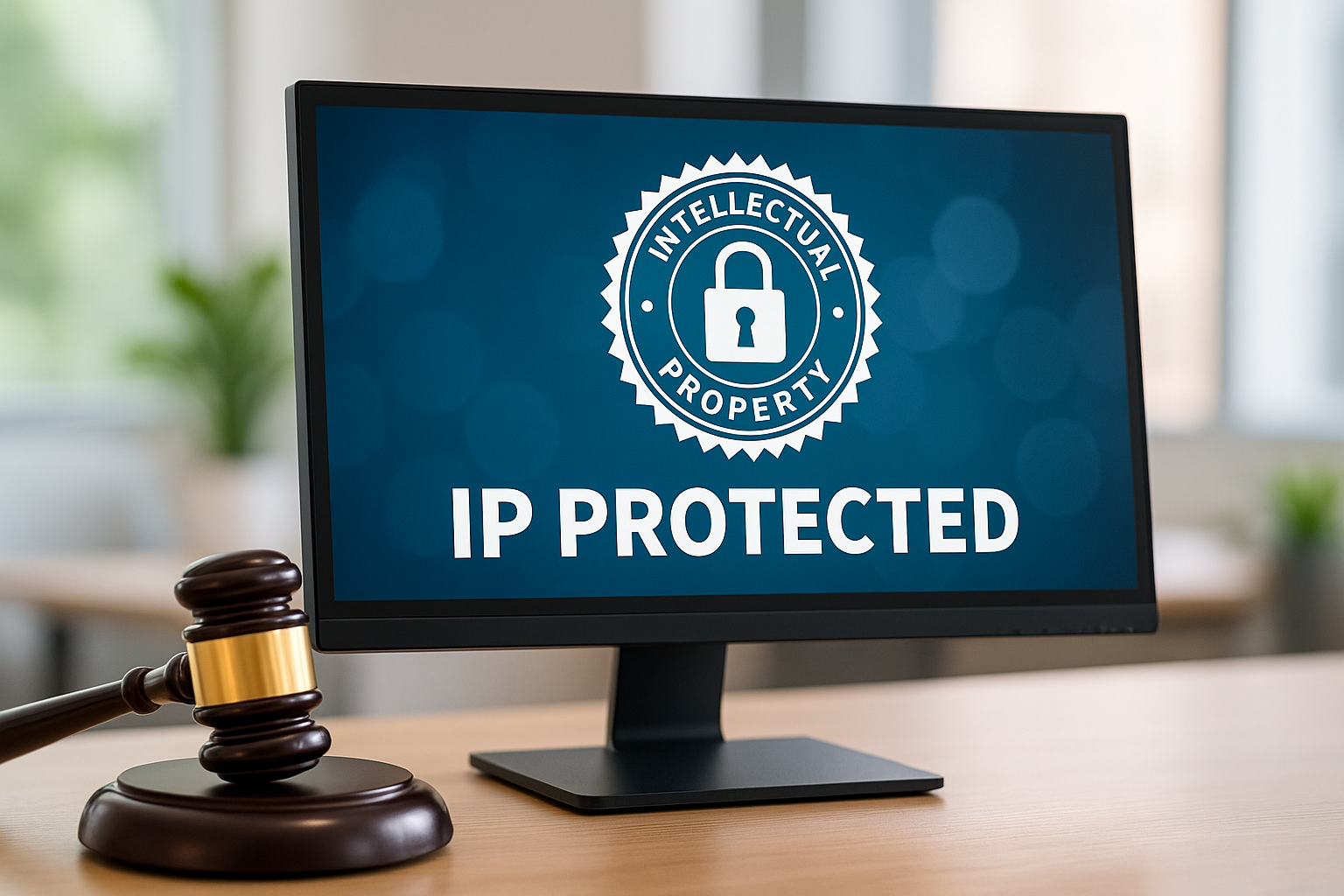📌 Quick Summary
1-Sentence Answer
Displaying your intellectual property (IP) protection on your website builds trust, deters copycats, and adds value for customers—so don’t be shy, show off your legal swagger!
The Article Overview
This article explores clever ways to display your website’s intellectual property protections, explains why showing off your IP boosts customer confidence, and shares actionable steps, real-world examples, common myths, legal cases, and expert insights—plus how to maximize your IP’s business value.
❓ Common Questions & Answers
Q1: Why should I display my IP protection on my website?
A: Displaying your IP protection deters would-be thieves, assures visitors your brand is legit, and builds customer trust faster than you can say “trademarked!”
Q2: What are common ways to show IP protection online?
A: Use visible IP badges, copyright and trademark notices, and even interactive pop-ups—anything to let folks know your site is protected and proud!
Q3: Does displaying IP protection actually boost business value?
A: Absolutely! Customers are more likely to buy, trust, and share from brands that protect their creations—and aren’t afraid to show it.
Q4: Will this stop people from copying my content?
A: While it won’t stop every copycat, clear IP displays make infringement easier to spot and legally pursue, so it’s a solid line of defense.
Q5: Do I need a lawyer to add IP notices to my website?
A: Not always! Basic copyright, trademark, and patent notices are easy to add. For unique or complex IP, a lawyer can help you look extra sharp.
📜 Step-by-Step Guide
-
Identify Your Website’s IP Assets:
List everything unique—logos, content, images, designs, slogans. Know what you’re protecting before you start flexing! -
Get Proper Protection:
Apply for copyrights, trademarks, or patents as needed. It’s hard to brag about protection you don’t have (no fake flexing, please!). -
Design IP Badges & Notices:
Create eye-catching badges or text for your footer, headers, or product pages. “© 2025 YourBrand” is a classic—so are shiny trademark badges. -
Add Legal Pages & Pop-Ups:
Dedicate a page to your IP policy and sprinkle reminders in pop-ups or tooltips. Transparency builds trust and keeps lawyers happy. -
Educate Your Customers:
Share blog posts or FAQs explaining your IP and its value. A little customer education goes a long way toward brand loyalty.
📖 Historical Context
The concept of protecting intellectual property dates back to ancient times. In medieval Venice, inventors could receive temporary monopolies—aka the OG patents—for novel inventions, paving the way for today’s legal landscape. Fast forward to the Statute of Anne (1710), and copyright was born, ensuring writers got credit for their witty sonnets (or bad puns). The 19th and 20th centuries saw IP law explode, with trademarks and patents becoming must-haves for businesses, and by the digital age, websites needed protection as much as physical goods.
Online IP displays first gained traction in the dot-com boom, when “Copyright 1999” footers became the web’s hottest accessory (right after animated GIFs). As online theft and plagiarism grew, so did the need for public, visible IP signals. Now, having a copyright or trademark badge isn’t just about legality—it’s a key customer trust signal. Consumers look for IP badges as proof a brand is legit, not a fly-by-night operation with a suspicious fondness for stock photos.
In today’s fast-moving digital world, your website’s IP is often your most valuable asset. Openly displaying your IP protection—like a badge of honor—signals to customers (and competitors) that you take your business seriously. Whether it’s a fancy seal, a no-nonsense copyright notice, or a sassy “Imitation is NOT the sincerest form of flattery!” popup, the point is to show you care about what’s yours—and your customers should, too.
🏢 Business Competition Examples
-
Apple:
Apple’s site proudly displays patented designs and “TM” notices for every product and slogan. Result? Instant credibility and a warning shot to competitors: “We defend our turf.” -
Nike:
Nike’s swoosh and “Just Do It” are trademarked—and their site features visible badges and legal language. Customers know they’re buying the real deal, not a knockoff. -
Shopify Stores:
Top Shopify sellers add copyright badges, DMCA seals, and even “Protected by Copyscape” icons. Result: Fewer copycats, more customer trust, and fewer support headaches. -
Canva:
Canva displays IP notices in their UI and website footers, educating users on licensing and sending a not-so-subtle message to competitors: “Original content lives here.”
💬 Discussion Section
Displaying your intellectual property on your website isn’t just about flexing your legal muscle—it’s about building trust, credibility, and a competitive moat in a crowded digital world. When customers visit your site, visible IP protection serves as a handshake: “We take our work (and yours) seriously.” It’s a proven way to deter plagiarism and theft, but more importantly, it reassures visitors that you’re invested in your creations.
Trust is the currency of the internet, and visible IP signals are your receipts. Studies show consumers prefer to buy from brands that protect their work—because if you care about your own assets, you’ll likely care about your customers, too. Plus, clear IP displays make it easier to take action when infringement occurs. If someone “borrows” your copy or rips off your product images, your IP badges and notices serve as evidence that you claimed ownership from the start.
Let’s talk value. Businesses that showcase IP protection often command higher prices and enjoy greater customer loyalty. Why? It’s all about perceived professionalism. Imagine two competing websites: one has a generic look and zero legal signals; the other features crisp copyright badges, trademark seals, and clear IP policies. Which would you trust with your money? The answer’s obvious, even if you’re not a legal eagle.
But there’s another angle: education. Many customers don’t know the value of IP—until you show them. Blogs, FAQs, and interactive pop-ups not only inform visitors but also position your brand as an expert. This proactive approach fosters loyalty and can even spark user-generated content (“Hey, I want my work protected, too!”).
Finally, displaying IP protection is a great internal motivator. Your team knows their work is valued and protected, boosting morale and creativity. Competitors, on the other hand, are put on notice: copying will cost you.
Of course, don’t go overboard. An overlawyered site feels intimidating. Aim for a friendly tone—think, “We love our creations and hope you do too (but please don’t steal them!)” With the right balance of humor and professionalism, your IP display can be both a shield and a magnet for loyal customers.
⚖️ The Debate
Pro-IP Display:
Visible IP protection deters theft, builds trust, and adds tangible business value. Customers are more likely to choose brands that demonstrate credibility and care about their creations. In legal disputes, displayed IP notices provide an extra layer of evidence. The cost? Minimal. The upside? Major.
IP Display Skeptics:
Some argue that IP displays are just window dressing. Sophisticated thieves ignore badges, and legal protection ultimately comes from registration, not website graphics. Overly aggressive legalese can even scare off customers or make a brand seem unapproachable. IP display is only effective when combined with real legal action and a thoughtful customer experience.
✅ Key Takeaways
-
Displaying your IP on your website builds trust and boosts business value.
-
Use clear, visible badges and legal language—don’t be shy!
-
Educate customers about your IP and why it matters.
-
IP display helps deter theft and supports legal claims.
-
A friendly, transparent approach wins customer loyalty.
⚠️ Potential Business Hazards
-
False Sense of Security:
Don’t assume that an IP badge alone will stop determined copycats—real protection requires registration and monitoring. -
Legal Overkill:
Overly complex legalese or aggressive pop-ups can scare customers away (save the courtroom drama for TV). -
Outdated Notices:
Forgetting to update copyright years or legal pages can make your site look neglected—and weaken your claims. -
Misleading Claims:
Don’t display protections you don’t have! Fake it, and you’ll break it (plus, you might get fined).
❌ Myths & Misconceptions
-
“A copyright badge = total protection.”
Nope! It’s a warning, not a force field. -
“Only big brands need IP displays.”
Small businesses benefit even more from the credibility boost. -
“IP displays make my site look unfriendly.”
Not if you keep it clear and approachable—think helpful, not hostile. -
“If it’s online, it’s up for grabs.”
Sorry, internet pirates! That’s not how the law works.
📚 Book & Podcast Recommendations
⚖️ Legal Cases
-
Feist Publications, Inc. v. Rural Telephone Service Co.
-
Key copyright case: Established that originality, not effort, grants copyright.
-
-
Apple Inc. v. Samsung Electronics Co.
-
Trademark/patent fight: Famous for the “look and feel” of devices, showing the power of IP display and protection.
-
-
Tiffany (NJ) Inc. v. eBay Inc.
-
Trademark enforcement: Proved the need for clear display of ownership to fight fakes online.
-
-
Viacom International Inc. v. YouTube, Inc.
-
Copyright notice: Underlined the value of visible notices and DMCA takedown policies.
-
📣 Expert Invitation
Want your IP protection game to shine? Share your own success stories, legal tips, or badge design fails at http://inventiveunicorn.com! Your insights could help thousands of creators and business owners—don’t be shy!
🔚 Wrap-Up Conclusion
Don’t keep your intellectual property in the shadows—put it on display! Show your customers (and competitors) that your website is protected, professional, and proud. In today’s digital world, your IP is your brand’s crown jewel, so don’t be shy—shine bright and wow your visitors!












